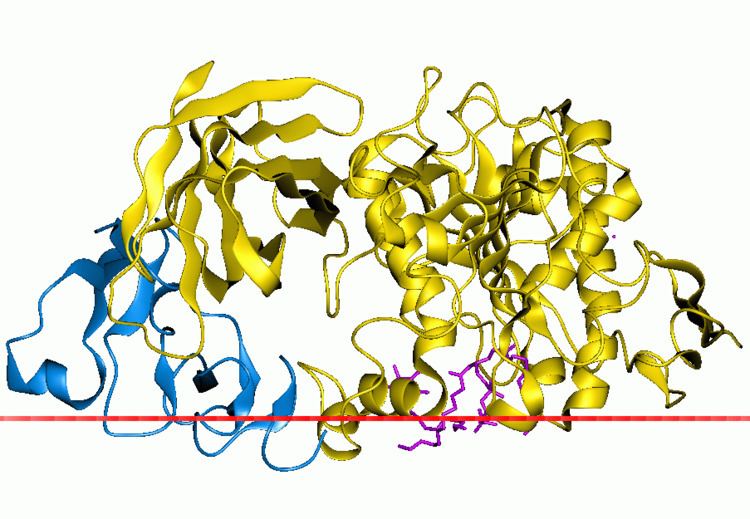Symbol Lipase InterPro IPR013818 SCOP 1lpa | Pfam PF00151 PROSITE PDOC00110 SUPERFAMILY 1lpa | |
 | ||
Triglyceride lipases (EC 3.1.1.3) are a family of lipolytic enzymes that hydrolyse ester linkages of triglycerides. Lipases are widely distributed in animals, plants and prokaryotes.
Contents
- Human pancreatic lipase
- Human proteins containing this domain
- Diagnostic importance
- Inhibitors
- References
At least three tissue-specific isozymes exist in higher vertebrates, pancreatic, hepatic and gastric/lingual. These lipases are closely related to each other and to lipoprotein lipase (EC 3.1.1.34), which hydrolyses triglycerides of chylomicrons and very low density lipoproteins (VLDL).
The most conserved region in all these proteins is centred on a serine residue which has been shown to participate, with an histidine and an aspartic acid residue, in a charge relay system. Such a region is also present in lipases of prokaryotic origin and in lecithin-cholesterol acyltransferase (EC 2.3.1.43) (LCAT), which catalyzes fatty acid transfer between phosphatidylcholine and cholesterol.
Human pancreatic lipase
Pancreatic lipase, also known as pancreatic triacylglycerol lipase, is an enzyme secreted from the pancreas. As the primary lipase enzyme that hydrolyzes (breaks down) dietary fat molecules in the human digestive system, it is one of the main digestive enzymes, converting triglyceride substrates found in ingested oils to monoglycerides and free fatty acids.
Triacylglycerol + 2 H2OBile salts secreted from the liver and stored in gallbladder are released into the duodenum, where they coat and emulsify large fat droplets into smaller droplets, thus increasing the overall surface area of the fat, which allows the lipase to break apart the fat more effectively. The resulting monomers (2 free fatty acids and one 2-monoacylglycerol) are then moved by way of peristalsis along the small intestine to be absorbed into the lymphatic system by a specialized vessel called a lacteal. This protein belongs to the pancreatic lipase family.
Unlike some pancreatic enzymes that are activated by proteolytic cleavage (e.g., trypsinogen), pancreatic lipase is secreted in its final form. However, it becomes efficient only in the presence of colipase in the duodenum.
In humans, pancreatic lipase is encoded by the PNLIP gene.
Human proteins containing this domain
Diagnostic importance
Pancreatic lipase is secreted into the duodenum through the duct system of the pancreas. Its concentration in serum is normally very low. Under extreme disruption of pancreatic function, such as pancreatitis or pancreatic adenocarcinoma, the pancreas may begin to autolyse and release pancreatic enzymes including pancreatic lipase into serum. Thus, through measurement of serum concentration of pancreatic lipase, acute pancreatitis can be diagnosed.
Inhibitors
One peptide selected by phage display was found to inhibit pancreatic lipase.
